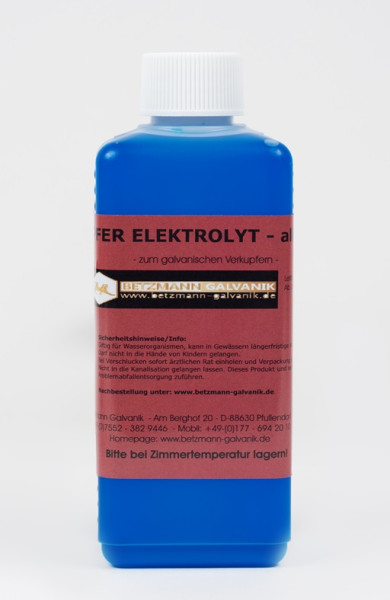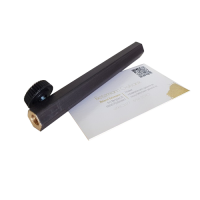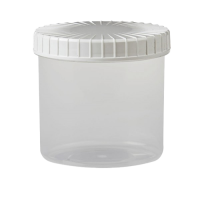€6.30 ohne MwSt.
Prices incl. VAT plus shipping costs
Ready to ship today,
Delivery time appr. 1-3 workdays
- Order number: BMG-093
Our copper electrolyte alkaline for acid-sensitive metals is cyanide-free!
Ideal for bath and tampon - / pin electroplating suitable
50 grams copper / liter
For use on iron and zinc metals
Easy to use and cyanide free
Ideally suited to copperplate even acid-sensitive materials (iron, zinc or steel). For example, copper plating can also be applied to materials that are attacked by the acidic copper electrolyte - for example, rusting steels or other ferrous materials. Copper plating effectively protects workpieces made of iron and steel against rust and gives them an attractive surface thanks to the typical red luster of the precious metal. Because of its good solderability, electroplated copper plating is ideal for the production of printed circuit boards or similar. Simply use the copper electrolyte together with a copper sheet as anode and you can quickly provide a component with a shiny copper coating yourself. The exact instructions for use can be found in our guide here in the download area!
For copper plating of non-acid sensitive materials please use the Betzmann Electroplating Bright Copper Electrolyte.
Alkaline copper electrolyte can be used in bath electroplating as well as in pin electroplating/tampon electroplating. Since it enables electroplating of acid-sensitive metals, it is suitable for many applications. Important properties of alkaline copper electrolyte are excellent leveling and good scattering. This color tone can be further enhanced by an additional coating with our bright copper electrolyte.
Applications for Copper Electrolyte Alkaline
Copper Alkaline prepares acid-sensitive materials for copper plating with acidic copper electrolyte. These include, for example, various ferrous materials or zinc.
A particular advantage is that it does not deposit electrolessly on iron, which would form a loose coating before electrodeposition begins. This increases adhesion to ferrous materials.
Basic copper electrolyte serves as an intermediate layer for acid-sensitive metals before final plating with acid electrolytic copper or other coatings.
Basic copper electrolyte is suitable for the following metals:
Lead, bronze, iron, copper, brass, zinc, tin, steel, zinc die casting and many others.
Basic copper is not suitable for aluminum, chromium and titanium. Aluminum requires pretreatment with aluminum activator
Please test all other metals not mentioned above for their suitability for electroplating before copper plating.
Application instructions for copper electrolyte alkaline
Copper Electrolyte Alkaline is suitable for all electroplating processes from bath electroplating to pin electroplating / pad electroplating. It already works at room temperature; however, it can be heated if necessary. The ideal temperature range is between 25 - 50°C.
Clean the workpiece thoroughly before treatment. Please remove dirt and rust with appropriate tools.
Handle the object only with disposable gloves to avoid transferring skin grease to the surface.
Parameters for the use of copper electrolyte alkaline
Copper anodes are optimal, nickel or tin anodes are also suitable.
Anode on positive pole - Workpiece on negative pole
Recommended electrode: Copper.
Operating Conditions and Deposit Data
| Voltage Range | 4 volts |
| Temperature | Above 15 °C |
| Copper Concentration | 36 g/l |
| Electrode | Copper, Carbon or Platinum(see notes) |
| Copper content in plate | 99.8% |
| Plating Rate at (3.5 volts, Platinum electrode) | 2 microns per minute (spot) |
| Hardness | 370 Hv |
| Density of deposit | 8.9 g/cm3 |
| Stress | Low – medium stress |
| Special storage requirements | None |
| Shelf life | 1 – 2 years |
| Health and Safety classification | Irritant |
| Special considerations | None |
| Transport (UN number) | None: Not classified as dangerous for transport |
Notes:
- We strongly advise against the use of stainless steel anodes for most of our plating processes
- Plating rates are calculated over a sample area which is permanently covered by swab.
Copper electrolyte alkaline / basic for acid sensitive materials
The copper gives a beautiful shiny finish. It can still be used with our Bronze-
Mixer can be used to mix different color shades from red gloss to white bronze
to be able. White bronze is increasingly desired and used as a nickel substitute.
Copper electrolyte alkaline for acid sensitive metals
Copper electrolyte alkaline (basic) can be used in both bath electroplating and pen plating / tampon plating. Our alkaline copper electrolyte contains no cyanides.
Since it enables electroplating of acid-sensitive metals, it is suitable for many applications. The important properties of alkaline copper electrolyte are excellent levelling and good dispersion. In addition, alkaline or basic copper impresses with an intensive and visually attractive color tone. An additional coating with our bright copper electrolyte can further enhance this color tone.
Application areas for copper electrolyte alkaline
Copper alkaline prepares acid-sensitive materials for copper plating with acid copper electrolyte. These include various ferrous materials or zinc.
A particular advantage is that it does not deposit on iron without current, which would form a loose coating before galvanic deposition begins. This increases the adhesion on ferrous materials.
Basic copper electrolyte serves as an intermediate layer for acid-sensitive metals before the final coating with acid electrolytic copper or other coatings.
Basic copper electrolyte is suitable for the following metals:
Lead, bronze, iron, copper, brass, zinc, tin, steel, zinc die-cast and many others
Basic copper is not suitable for aluminum, chrome and titanium. Aluminium requires a pretreatment with the aluminium activator
Please test all other metals not mentioned above for their suitability for galvanic copper plating before copper plating
Application notes for copper electrolyte alkaline
Copper electrolyte alkaline is suitable for all electroplating processes from bath plating to pen plating / pad plating. It already works at room temperature; however, it can be heated up if required. The ideal temperature range is between 25 - 50°C.
Clean the workpiece thoroughly before treatment to remove grease and oil. Please remove dirt and rust with appropriate tools. Handle the object with disposable gloves only to avoid transferring skin grease to the surface.
Parameters for the use of copper electrolyte alkaline
Anodes made of copper are optimal, nickel or tin anodes are also suitable.
Anode on positive pole - workpiece on negative pole



Always use gloves and protective goggles and do not inhale the vapors / aerosols. Use only in well ventilated areas!
Identification of the mixture:
Copper electrolyte alkaline
(contains copper sulfate, potassium hydroxide)
GHS05 GHS09 GHS07
Signal word: Danger
H-phrases:
H314: Causes severe skin burns and eye damage.
H411: Toxic to aquatic life with long lasting effects.
P phrases:
P102: Keep out of the reach of children.
P280: Wear protective gloves / clothing / eye protection.
P301 + P330 + P331: IN CASE OF INSPECTION: Rinse out mouth. Do NOT induce vomiting.
P303 + P361 + P353: IF ON SKIN (or hair): Remove all contaminated clothing immediately. Wash skin with water/shower.
P305 + P351 + P338: IF IN EYES: Rinse cautiously with water for several minutes. Remove existing contact lenses if possible. Continue to rinse.
P501: Dispose of contents/container to hazardous waste.
































































